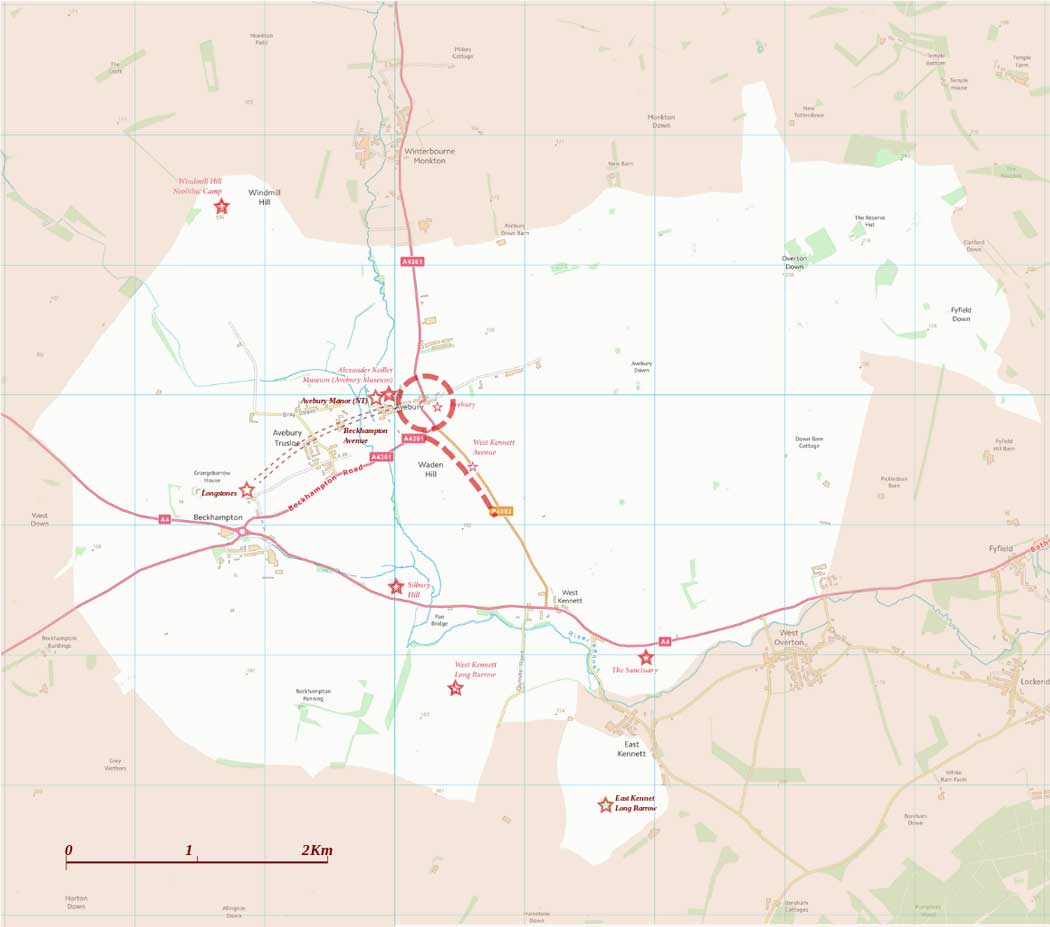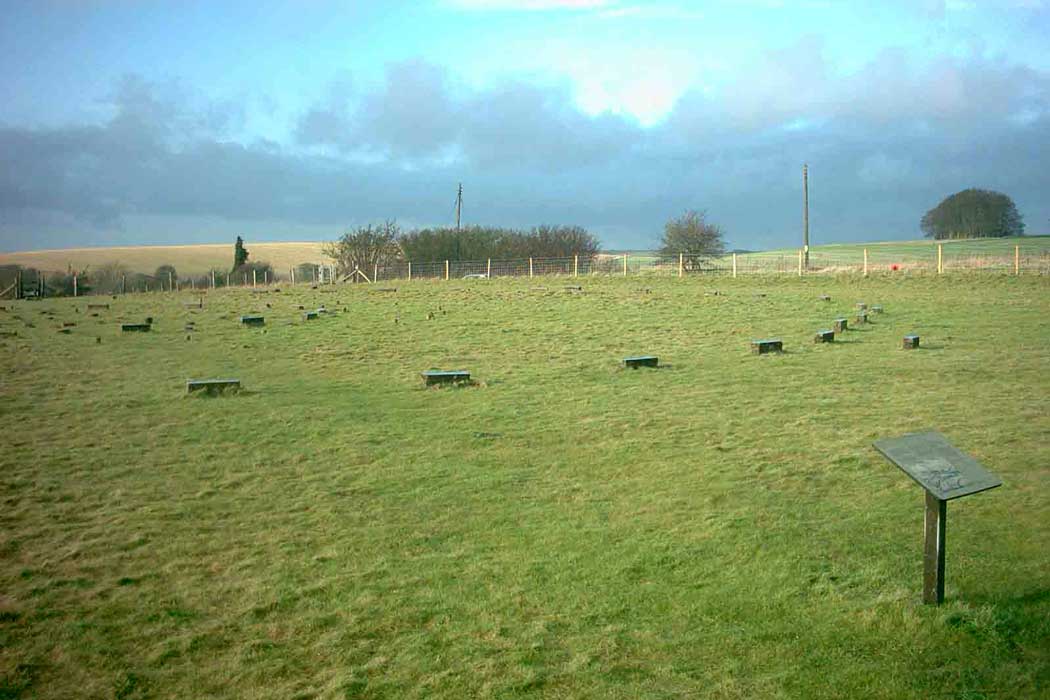Avebury is an important megalithic monument that consists of three stone circles enclosed by a ditch plus an avenue of stones. Although the stones are smaller than Stonehenge, the monument is older and it covers a larger area encompassing part of the village of the same name.
The name Avebury refers to both the henge and also the village, which can lead to some confusion. On this page, we use the name Avebury to refer to the Neolithic henge monument and any reference to the village of Avebury will be simply referred to as ‘the village’. However, elsewhere on this website, the village will be called by its name (Avebury) and the henge monument will be referred to as either Avebury henge or the Avebury stone circle.
The village is an integral part of Avebury with part of the village including a pub and several houses located inside the henge.
It is the world’s largest megalithic stone circle.
The history of Avebury
The start of the Neolithic period, around 6,000 years ago, coincided with the change from hunter-gathering to an agricultural-based lifestyle that saw major social changes with people settling down to develop communities and religious beliefs. This period saw the construction of primitive monuments and towards the end of this era, large scale monuments such as Avebury and Stonehenge were being built.
Avebury dates from around 4,500 years ago and it is believed to have been built between 2,850 and 2,200 BC during the Neolithic period, which is also known as the New Stone Age.
The site had become abandoned by the Iron Age. However, there is evidence of Roman settlement in the area and the village dates from the Early Middle Ages and during this time some of the standing stones were destroyed by the local villagers.
The 17th-century antiquarians John Aubrey and William Stukeley studied Avebury and they made records of the site that have given us an insight into aspects of Avebury that have since been destroyed. In the 20th century, Alexander Keiller led a thorough archaeological investigation of Avebury that was responsible for reconstructing parts of the monument.
What was the purpose of Avebury
Like Stonehenge, there are many mysteries regarding the purpose of the monument with various theories suggesting that the henge and stone circle was used for religious ceremonies and peripheral areas of the site, such as West Kennet Long Barrow, were used as tombs for human burials.
Avebury today
The village of the same name dates from the medieval period and, over time, has expanded into the henge monument. It is a unique site and the only place in the world where you can find a local village pub located inside a Neolithic stone circle.
Because Avebury is an integral part of the village, there is no charge to visit the site and visitors are able to go inside the stone circle and walk among the stones.
The site is owned and managed by the National Trust and it is part of the same World Heritage Site that also includes Stonehenge, 27km (17 miles) to the south. The cost of managing and maintaining Avebury is shared between English Heritage and the National Trust, who jointly operate the Alexander Keiller Museum in the village. Members of either organisation can use the car park for free and also have free access to the museum.
Around 250,000 people visit Avebury every year, a fraction of the 1.4 million that visit Stonehenge.
![Aerial photo showing how the village has expanded into the Avebury henge monument. (Photo: Detmar Owen [CC BY-SA 4.0])](https://englandrover.com/wp-content/uploads/2018/09/avebury-aerial.jpg)
What to see at Avebury
Avebury consists of a large henge (the circular-shaped ditch and its bank) that contains a large outer stone circle and two smaller stone circles in the centre of the monument. The site is part of a prehistoric landscape that also includes nearby monuments such as West Kennet Long Barrow, Windmill Hill and Silbury Hill.

Avebury henge and stone circles
The henge and the stone circles comprise the main part of the Avebury site and this is all that most visitors to Avebury see. It comprises a large henge with a large outer stone circle (the world’s largest) and two smaller stone circles. The smaller circles are located one above the other and are separated by the village’s High Street.
Visitors are free to wander around and even touch the stones (something that you simply can’t do at Stonehenge).
![Part of Avebury’s South Inner Circle. (Photo by David Iliff. Licence: [CC BY-SA 3.0])](https://englandrover.com/wp-content/uploads/2018/09/avebury-south-inner-circle.jpg)
West Kennet Avenue
The 4,600-year-old West Kennet Avenue is a 2.5km- (1½ mile)-long path that links the Avebury stone circle with The Sanctuary. The first 800m (½ mile) of the route is lined by a series of standing stones.
![West Kennet Avenue facing northwest towards Avebury. (Photo by David Iliff. Licence: [CC BY-SA 3.0])](https://englandrover.com/wp-content/uploads/2018/09/west-kennet-avenue.jpg)
The Sanctuary
The Sanctuary was a stone and timber circle around a 40-minute walk southeast of the village. The site is around 4,500 years old and concrete markers are located to indicate the position where the stones and timber posts once stood.

West Kennet Long Barrow
West Kennet Long Barrow is a chambered long barrow (a Neolithic tomb) just a short distance south of Avebury henge. At 100m- (328 ft)-long by 20m- (66 ft)-wide, it is considerably larger than most other long barrows and it consists of a stone chamber covered by a grassy mound.
![Inside the stone chamber of West Kennet Long Barrow. (Photo: Jarkeld [CC BY-SA 4.0])](https://englandrover.com/wp-content/uploads/2018/09/west-kennet-long-barrow.jpg)
Windmill Hill
Windmill Hill is a Neolithic causewayed enclosure that was first occupied around 3,800 BC and archaeological excavations in the 1920s have uncovered pottery and other artefacts. It is located around 1.6km (1 mile) northwest of the stone circle.
Silbury Hill
Silbury Hill is a chalk mound around a half-hour walk south of Avebury. At 39.3m (129 ft), it is Europe’s tallest man-made mound.
![Silbury Hill after heavy rain. (Photo: Swindonian [CC BY-SA 4.0])](https://englandrover.com/wp-content/uploads/2018/09/silbury-hill.jpg)
Visiting Avebury
Although it is not accessible by rail, Avebury is easily accessible bus and with Stagecoach bus route 49 stopping outside the Red Lion pub in the centre of the henge en route between Swindon and Devizes. Swindon’s Bus Company’s routes 42 and X76 connect the village with Marlborough, with route 42 stopping outside the Red Lion in the village centre and X76 stopping in the nearby villages of Beckhampton and West Kennett, which are both around a half-hour walk from Avebury.
Visitors are free to wander around the henge and stone circles as well as the other Neolithic monuments at Avebury. This means that you have much greater access to the stones at Avebury than visitors would get at Stonehenge.
Because the Avebury henge runs right through the centre of the village, there is no admission charge and you can visit at any reasonable time during daylight hours.
The visitor reception centre is in a 17th-century threshing barn. Here you can get information about Avebury and also buy tickets for the manor and the museum. The visitor centre also has a cafe and gift shop.
Don’t feel that you have to eat at the visitor centre cafe as there are several other places to eat and drink in the village including a local pub right inside the stone circle. Not only is the Red Lion a lovely 17th-century pub with a thatched roof and outdoor seating, but it is also one of the most haunted pubs in the United Kingdom and the only pub in the world that is located inside a stone circle.
You could spend anywhere from 15 minutes to half a day exploring the site. While a lot of people driving through the area will stop, get out of the car and take a short walk around the stones, it is also easy to spend hours here, particularly if you take the time to walk to some of the sites away from the henge.


There are no comments yet.